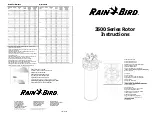
3 of 3
LPN00428X0001A0_A
© 2016 Cree, Inc. All rights reserved. For informational purposes only. Content is subject to change.
See lighting.cree.com/warranty for warranty and specifications. Cree
®
and Essentia
®
are registered
trademarks of Cree, Inc.
US: lighting.cree.com
T
(800) 236-6800
F
(262) 504-5415
Canada: www.cree.com/canada
T
(800) 473-1234
F
(800) 890-7507
ELECTRICAL CONNECTIONS
STEP 1
• After installation is complete, supply AC power to the emergency
driver and join the converter connector.
STEP 2
• At this point, power should be connected to both the AC driver and
the emergency driver, and the Charging Indicator Light should
illuminate indicating the battery is charging.
STEP 3
• A short-term discharge test may be conducted after the emergency
driver has been charged for one hour. Charge for 24 hours before
conducting a long-term discharge test. Refer to OPERATION.
STEP 4
• In a readily visible location, apply supplied label “CAUTION - This
Unit Has More Than One Power Connection Point. To Reduce The
Risk Of Electric Shock, Disconnect Both The Branch Circuit-Breakers
Or Fuses And Emergency Power Supplies Before Servicing.”
AC LED
DRIVE R
WAL L
S WITCH
UNSWITCH ED HOT
YE LLOW
COMMON
WHIT E
YE L /BL K
OUTPU T
WHI TE
WHT/BLK
WHT/RE D
BLUE
OUTPUT
B LACK
BL ACK
L ED (+)
L ED ( - )
LED LOAD
L
E
D
D
R
I
V
E
R
E
M
E
R
G
E
N
C
Y
F
L
E
X
A
F
L
E
X
B
VIOLE T
VIOLE T
B ROW N
BROW N
CON VERTE R
CONN ECTOR
RED
WHIT E
CHARGIN G IN DICATOR
LIGHT/TES T SWITCH
+DIM- VIOLE T
- DIM- GRAY
OPERATION
STEP 1
• During normal operation when AC power is applied, the charging indicator light is illuminated, indicating that the battery is being charged. When
power fails, the emergency LED driver automatically switches to emergency power (internal battery), operating the LED load for a minimum of 90
minutes. When AC power is restored, the emergency driver returns to the charging mode.
MAINTENANCE
STEP 1
• Although no routine maintenance is required to keep the emergency driver functional, it should be checked periodically to ensure that it is working.
The following schedule is recommended:
• Visually inspect the charging indicator light monthly. It should be illuminated.
• Test the emergency operation of the luminaire at 30-day intervals for a minimum of 30 seconds. The LED load should operate at reduced
illumination.
• Conduct a 90-minute discharge test once a year. The LED load should operate at reduced illumination for at least 90 minutes.
CAUTION:
Changes or modifications not expressly approved could void your authority to use this equipment.
This device complies with part 15 of the FCC Rules. Operation is subject to the following two conditions: (1) This device may not cause harmful
interference, and (2) this device must accept any interference received, including interference that may cause undesired operation.
This equipment has been tested and found to comply with the limits for a Class A digital device, pursuant to part 15 of the FCC Rules. These limits are
designed to provide reasonable protection against harmful interference when the equipment is operated in a commercial environment. This equipment
generates, uses, and can radiate radio frequency energy and, if not installed and used in accordance with the instruction manual, may cause harmful
interference to radio communications. Operation of this equipment in a residential area is likely to cause harmful interference in which case the user
will be required to correct the interference at his own expense.
CAN ICES-005 (A)/NMB-005 (A)
FCC NOTICE





















